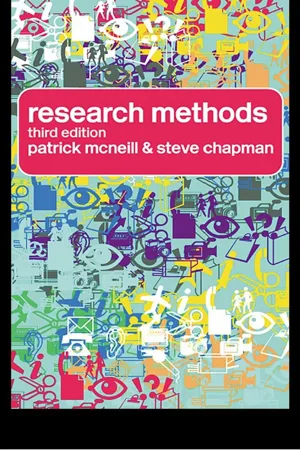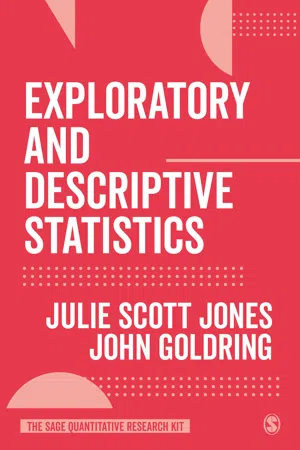Psychology
Primary and Secondary Data
Primary data refers to information collected firsthand through methods like experiments or surveys. This data is original and specific to the research question. Secondary data, on the other hand, is gathered from existing sources such as books, articles, or databases. It is already available and can provide valuable background information for research studies.
Written by Perlego with AI-assistance
Related key terms
Related key terms
1 of 4
Related key terms
1 of 3
10 Key excerpts on "Primary and Secondary Data"
- eBook - ePub
Advanced Qualitative Research
A Guide to Using Theory
- Michelle O?Reilly, Nikki Kiyimba, Michelle O?Reilly, Michelle O?Reilly, Michelle O?Reilly, Michelle O?Reilly, Michelle O?Reilly, Michelle O?Reilly, Michelle O?Reilly, Michelle O?Reilly(Authors)
- 2015(Publication Date)
- SAGE Publications Ltd(Publisher)
A common differentiation between different types of research data has been to categorise them as ‘primary data’ or ‘secondary data’. These have been understood differently within different disciplines. For example, there is a discrepancy between what historians mean by primary versus secondary sources and how social scientists employ the concepts. While the literature on this distinction has been rather sparse, primary data are generally understood to be the initial data specifically collected by the original researcher for their research purposes, whereas secondary data are understood to be collected by someone other than the researcher. In other words, primary data have been considered to be the face-to-face collection (such as interviews and focus groups), whereas secondary data have been understood to be existing available sources. It is important to make a distinction at this point between secondary data and secondary data analysis, which is the reanalysing of data collected by another researcher, a point we return to later in the chapter.We see this distinction between Primary and Secondary Data as problematic for qualitative research. The reasons for this are that this differentiation fails to account for the arguments related to ‘researcher-generated’ and ‘naturally occurring’ data (as discussed in Chapter 4 ). It also fails to account for the defining parameters that distinguish the particular characteristics of ‘research data’ from general information which is colloquially referred to as ‘data’.While we acknowledge that there are several ways in which data might be differentiated, we also propose one particularly useful distinction between privately solicited research data and publicly available data which could form part of a research data corpus. In the example above, pre-existing data were privately secured by the researcher through negotiations and ethical procedures with the organisation. In this sense they are privately solicited research data. In contrast, some naturally occurring research data are publicly available, such as television documentaries and newspaper and magazine articles. The reason we offer this distinction between privately solicited and publicly available, naturally occurring data is that the former data corpus would solely be available to that individual researcher whereas publicly available data could potentially be simultaneously collected by numerous researchers. This has implications for ways in which secondary data analysis - eBook - ePub
- Robert E Stevens, David L Loudon, Morris E Ruddick, Bruce Wrenn, Philip K Sherwood(Authors)
- 2012(Publication Date)
- Routledge(Publisher)
secondary data. Primary data are those data that are collected for the first time by the researcher for the specific research project at hand. Secondary data are data previously gathered for some other purpose. The terms “primary” and “secondary” may cause some confusion. These terms have nothing to do with the relative importance of the information. Whether the data are primary or secondary is determined by whether they originated with the specific study in consideration or not.The first tenet of data gathering among researchers is to exhaust all sources of secondary data before engaging in a search for primary data. Many research questions can be answered more quickly and with less expense through the proper use of secondary information. However, caution must be used to ensure that primary sources of secondary data are used since they are generally more accurate and complete than secondary sources of secondary data.SECONDARY DATA SOURCESThe first problem that confronts a researcher in initiating a secondary data search is the massive amount, wide variety, and many locations of secondary data. Some method of logically summarizing the sources of secondary data is helpful. Most textbooks on the subject divide secondary data sources into two groups: internal data sources and external data sources.Internal secondary data sources are closest at hand since they are found within the organization initiating the research process. These internal data have been collected for other purposes but are available to be consolidated, compared, and analyzed to answer the new research question being posed. This is particularly true of organizations that have sophisticated management information systems that routinely gather and consolidate useful marketing, accounting, and production information. - eBook - ePub
- Richard Tewksbury, Elizabeth Ehrhardt Mustaine(Authors)
- 2014(Publication Date)
- Routledge(Publisher)
Chapter 5 Original vs. Secondary Data Collection: The New Dilemma for ResearchJana L. Jasinski* University of Central FloridaOriginal vs. Secondary Data Collection
For a new researcher, the process of developing a new empirical study can be, at the same time, both exciting and overwhelming. Among the many decisions that need to be made are the type and source of data to be collected. At this stage one of the most basic choices researchers are faced with is whether to collect original data or to use secondary data. Throughout this chapter the pros and cons of each of these types of data are discussed.What Is Secondary Data Analysis?
Research using data that were created for some purpose other than that of the current research project is called secondary data analysis. The data can take generally two formats, pre-existing data sets (data files that are ready to be analyzed by the researcher, e.g., General Social Survey [Davis & Smith, 1996]) or existing statistics (available information that needs to be organized into a format that can be analyzed by the researcher, e.g., burglary rates for the 100 largest cities in the United States).Sociology, criminology, and criminal justice as disciplines have a long history of conducting secondary data analysis. Sociologist Emile Durkheim ([1897] 1951), for example used existing data including suicide rates, religious affiliation, and marriage and divorce rates to examine fluctuations in suicide. Durkheim's goal was to examine the relationship between indicators of social solidarity and integration, and the deviant act of suicide. To examine the geographic distribution of juvenile delinquency Shaw and McKay (1942) used official data on delinquents brought before the juvenile court, committed to correctional institutions, and dealt with by probation officers. In addition to research on crime and delinquency, available statistics have been used to investigate a variety of issues. Karl Marx, for example, used economic statistics to test his theory of class struggle ([1867] 1967) and Max Weber used church documents to investigate the relationship between religion and sociopolitical behavior ([1904] 1977). - eBook - ePub
- Steve Chapman, Patrick McNeill, Patrick Mcneill(Authors)
- 2005(Publication Date)
- Routledge(Publisher)
5 Secondary dataThe data that is used by sociologists may be ‘primary’ or ‘secondary’. Primary data is collected first hand by the sociological researcher, mainly through the use of research methods such as surveys, interviews, or participant observation. Secondary data is evidence used by sociologists as part of their research which has been produced for non-sociological reasons, either by organizations such as the state or by individuals. This type of secondary data usually takes the form of official statistics and various types of ‘documents’.Data from earlier sociological research
Sometimes, a researcher will use data from previous sociological studies as the basis for new work. The 1980 Black Report (Townsend and Davidson 1982) documented the pattern of health inequalities in Britain, drawing on sociological evidence collected in the early 1970s. The report prompted a mass of sociological research throughout the 1980s which was gathered together in 1987 in the form of a Health Education Council report, The Health Divide (Whitehead 1988), which documented growing inequalities in both mortality and morbidity rates across social classes in the UK.Sally Power et al.’s Education and the Middle Class (2003) deliberately sets out to mirror Jackson and Marsden’s 1962 research Education and the Working Class. Much of the empirical research carried out by Power et al. into the social backgrounds and educational aspirations of middle-class families and their children is based on previous research carried out by educational sociologists such as Bernstein, Halsey, Ball and others in the last forty years.A great deal of past sociological research and the research tools used, e.g. questionnaires, interview schedules, etc. are now available to contemporary sociologists on data archives accessible via the internet. It is therefore now possible for contemporary sociologists to tap into extensive amounts of previously collected data based on large representative samples. This is obviously advantageous to researchers with very limited funds although it is important that such data is treated cautiously because there may be important discrepancies between past and present day researchers on how they define the concepts used in their hypotheses, how they select their samples, etc. - Nicholas Walliman, Jane Appleton(Authors)
- 2009(Publication Date)
- SAGE Publications Ltd(Publisher)
So, why do we not rely on primary data for all our research? After all, they get as close as possible to the truth. There are several reasons, the main being time, cost and access. Collecting primary data is a time consuming business. As more data usually means more reliability, the efforts of just one person will be of limited value. Organizing a huge survey undertaken by large teams would overcome this limitation, but at what cost? Also, it is not always possible to get direct access to the subject of research: for example, many historical events have left no direct evidence. Also, if you are undertaking a critical literature review you will be reviewing primary research studies (empirical research) and using someone else’s primary data, to make sense of the research literature on a particular topic, a process known as secondary analysis. Secondary data Secondary data are data that have been interpreted and recorded, they often summarize or quote content from primary sources (Burns and Grove, 2004). We could drown under the flood of secondary data that assails us every day. News broadcasts, magazines, newspapers, documentaries, advertising and the Internet all bombard us with information wrapped, packed and spun into digestible soundbites or pithy articles. We are so used to this that we have learned to swim, to float above it all and only really pay attention to the bits that interest us. This technique, learned through sheer necessity and quite automatically put into practice every day, is a useful skill that can be applied to speed up your data collection for your dissertation. Chapter 8 discusses the sources of secondary information. Here we will look at the different types of secondary data that you might want to uncover. Depending on the subject of your dissertation, particular types of data will probably be more important to you than others- eBook - ePub
Writing in Political Science
A Practical Guide
- Diane E. Schmidt(Author)
- 2019(Publication Date)
- Routledge(Publisher)
5 Creating Evidence with Primary and Secondary Data Students should identify the information (data) they need for their research early in the research process. If it is not available in secondary form, students must then determine if it is feasible within the research project’s time frame to use primary data to produce the information they need for the project. Researchers produce primary data by locating raw data or by creating the data. To produce primary data as evidence, students must collect it from either original documents, a questionnaire, or personal interviews. If such research is on human beings and in conjunction with coursework or campus activities, students generally must obtain permission to do the research from their school’s Human Subjects Committee. Once collected, researchers use one or more methods of data reduction to process the data. This chapter begins with an overview of secondary data sources and then progresses to a discussion of primary data collection. To assist students in deciding how to use such data as evidence, this chapter also provides a primer on data reduction methods. SECONDARY SOURCES OF QUANTITATIVE DATA A secondary data source is a set of data not collected by the student. Students who do not have the time or the need for primary data collection may analyze existing sources of data to provide evidence for their research papers. Public agencies, private organizations, and scholars often collect such data for particular purposes. The data collected by others and used to create their analyses may be available free of charge, through subscription services, and/or for a fee. The advantage of using data collected by others is that students save time and, in some cases, money - eBook - ePub
- Neven Šerić, Jasenko Ljubica(Authors)
- 2018(Publication Date)
- Emerald Publishing Limited(Publisher)
Primary research classifies as field research as opposed to the secondary research data collected by researchers in the office (desk research). There are two basic methodological approaches to collect primary data: the methods of observation and testing (Grbac & Meler, 2007). In addition to these two methods, implementation of the experiment method is also common in the sports industry (Lough & Sutton, 2012; Shilbury et al., 2003). Test method provides a significant amount of data, which is frequently used. All three methods can be used separately but are more effective when combined (Meler, 2005). Combining methods to achieve synergistic effects, which provide broader insights into the core of the research problem, is the first step in gaining deeper insights of cause–effect relationships between the variables of the studied sport phenomenon, which is the fundamental goal of primary research. The data often refer to facts, conditions and specific situations. Primary data is classified according to the characteristics of examinees – fans, sponsors and other. Especially valuable primary data for sport entities are those that explain the opinions, attitudes and behaviour of visitors of sport events. Psychological variables that are useful are those providing information about lifestyle, personality and motives of individuals who visit sport events. Research techniques include special procedures within the specific basic method (testing, observation and experiment). In practical terms, this manifests in different ways during research, such as posing questions and gaining insights on behaviours connected with the specific dilemma. Primary data in the sports industry also represent different geographic, demographic and socio-economic characteristics that have significant repercussions not only on the behaviour of visitors of sport events but also on global trends related to the sport - eBook - ePub
Workplace Research
Conducting small-scale research in organizations
- Zina O?Leary, Jennifer S. Hunt, Zina O?Leary, Zina O?Leary, Zina O?Leary, Zina O?Leary, Zina O?Leary, Zina O?Leary, Zina O?Leary, Zina O?Leary, Zina O?Leary, Zina O?Leary, Zina O?Leary(Authors)
- 2016(Publication Date)
- SAGE Publications Ltd(Publisher)
6 Gathering Primary DataChapter preview
- The benefits and challenges of primary data
- Seeking respondents
- Collecting survey data
- Collecting interview data
- Managing the workload
The Benefits and Challenges of Primary Data
Primary data is data collected by researchers expressly for their research purposes – it is data that does not exist independent of the research process. Primary data is current, it is wholly owned by the researcher, and most importantly, it is targeted at specific issues the researcher is exploring. It can be used to explore an emerging issue or update understanding of an existing one. It allows us to ask – what exactly is the root of the problem? How can we tackle this issue? What solutions have the greatest support?When situations that were once understood evolve and novel problems arise, primary data may provide key information to aid responses, solutions and adaptations. It is, therefore, a critical resource for decision-making. In external environments, primary data can help make sense of changes and developments that impact organizations; in the internal environment, it can also drive improvements by applying new information to product and service design, enhancing offerings and improving the organizational process.In his research on organizational success, Choo (1996) identifies ‘intelligent learning organizations’ as those most effective in managing informational needs, gathering and use. Primary data is the first step towards anticipating, adapting and responding to challenges.It is worth noting that primary data is valued in so far as it helps to accomplish these goals. Only relevant and timely information is useful; irrelevant or confusing information merely exacerbates problems. For this reason, primary data collection must be targeted and appropriate: - eBook - ePub
- Julie Scott Jones, John Goldring(Authors)
- 2022(Publication Date)
- SAGE Publications Ltd(Publisher)
Archival and Secondary Data Analysis).Yours or mine?
The first decision we must make is whether we want to collect our own data (known as primary data collection) or use data collected by other researchers (known as secondary data collection). As we will see, there are pros and cons to using both types, which we must consider prior to starting any piece of research; the type we ultimately choose will shape our analysis, limiting or expanding its scope.What is primary data?
Primary datais data directly collected by the researcher; primary quantitative data is usually gathered using questionnaire-based or attitudinal surveys (or indeed surveys which combine both elements). Volume 2 in this series (Survey Research and Sampling) covers the specifics of survey design and method in much more detail than this chapter does, so you might want to read it if you are planning to collect your own data. Researchers use a variety of ways to distribute surveys, including telephone, mail and increasingly online (using social media, websites and email). Indeed, these days most of us are possibly quite used to completing short online surveys seeking to assess how ‘satisfied’ we may be with a particular product or service. The advantage of research using primary data is that researchers shape and control the whole process including design and distribution; therefore, they can be confident that the data collected best fits with their particular research question. This is often why students want to conduct their own quantitative data collection. Yet this is also a potential weakness of working with primary data: it is only as good as you (the researcher) make it. Can you guarantee that your attitudinal survey is valid, that is, it actually measures the attitudes you want to measure? And is it reliable? In other words, could someone else use your attitudinal survey and obtain similar results? Designing your own data collection puts much more pressure on you to get the design ‘right’, which takes more time (extensive literature reviews, running multiple pilot surveys and refining questions) than you might think. Surveys are notorious for their low response rates (as low as 10%–15% for some types), especially as people are increasingly bombarded with online or email customer surveys. It can take considerable resources and time to design-in good response rates. There is also the potential for over- or under-representation of specific groups, depending on your sampling strategy. When you start factoring in these sorts of issues, then primary survey-based quantitative data collection becomes much more costly in time, effort, data quality and possibly money than it first appears. It is not as simple as sending out a quick email questionnaire. The key strengths of quantitative methodology, as we noted in Chapter 1 - Bonita Kolb(Author)
- 2008(Publication Date)
- Routledge(Publisher)
Objectives- Explain the advantages of collecting secondary data at the start of the research process
- Identify the necessary requirements of usable secondary data
- Explore how organizations can use secondary research
- Describe the secondary data sources that are available to the researcher
- Understand the steps necessary to complete a successful online data search
IntroductionFew people are interested in reading about how to conduct secondary research. After all, what the reader of this book wants to know is how to conduct a survey or a focus group, not how to sit at a computer reading about other people’s research. What is important to remember is that conducting primary research costs both time and money. If another organization has already studied the issue affecting the organization, why not learn from their effort? Besides published research reports, there are many sources of information, such as articles in magazines and newspapers, that will have useful information that addresses the research issue. Online sources such as blogs and websites can also be used. This secondary research can help the organization find threats and opportunities and also information on the public, the external environment and competitors.Using secondary data at the start of the research processThere are two types of data that a marketing researcher can collect. Primary data is information that is collected directly from research participants, the primary source. The other source of data available to the nonprofit organization is secondary data created as the result of previously conducted research. This information has already been collected through either quantitative or qualitative studies by another organization, a company or a government agency. Qualitative secondary data is also available through a number of different sources such as articles and online sources such as blogs and websites (Stebbins, 2006). The benefits of using secondary data include lowering the research costs, finding information that can help in the design of the research methodology and general background information on the issue of concern (see Table 5.1
Index pages curate the most relevant extracts from our library of academic textbooks. They’ve been created using an in-house natural language model (NLM), each adding context and meaning to key research topics.
Explore more topic indexes
Explore more topic indexes
1 of 6
Explore more topic indexes
1 of 4









